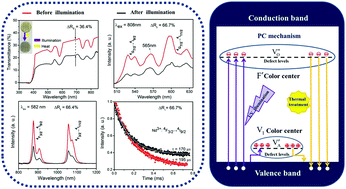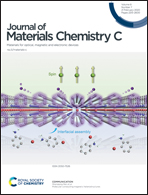Reversible multi-mode modulations of optical behavior in photochromic-translucent Nd-doped K0.5Na0.5NbO3 ceramics
Abstract
A novel photochromic (PC) ferroelectric material, Nd3+-doped K0.5Na0.5NbO3 translucent ceramic, was fabricated by a conventional solid method. The ceramic shows moderate optical transparency due to its dense microstructure, as well as good photoluminescence (PL) properties of up-conversion (UC) emission in the visible region and down-shifting (DS) emission in the near-infrared region. Simultaneously, the colors of all the ceramics turn darker after 365 nm illumination, and then recover to their initial states upon thermal stimulus (210 °C, 10 min), exhibiting a typical PC phenomenon. In particular, the effect of the PC behavior on PL lifetimes of Nd3+ was investigated. Multi-mode reversible modulations of various optical behaviors were realized based on the PC behavior, especially for the regulation of near-infrared emission. And the maximum modulation ratios of transmittances, UC or DS PL intensities and luminescence lifetimes are 43.0%, 66.7%, 66.4% and 12.8%, respectively. Owing to high-temperature sintering and Nd3+ substitution in the ceramics, cation and oxygen vacancies appear to produce F′ and V1 color centers, which are in charge of the PC behavior and corresponding modulations. These results suggest that the ceramics are a promising PC material in visible and near-infrared optical data storage, photo-switches, and optoelectronic devices. Meanwhile, they also provide insights into the applications of rare-earth Nd3+ in other inorganic PC ferroelectric materials.



 Please wait while we load your content...
Please wait while we load your content...